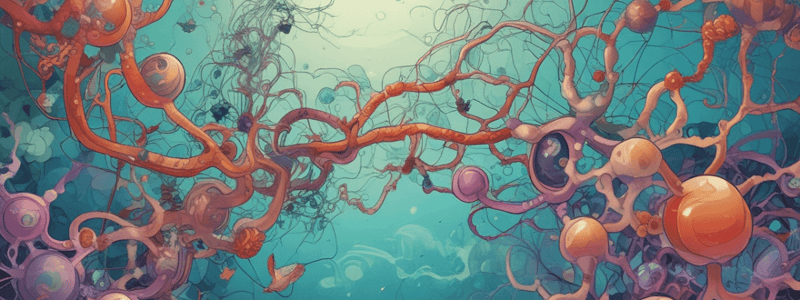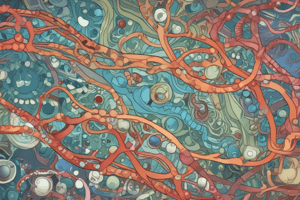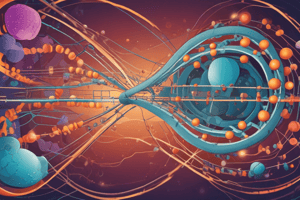Podcast
Questions and Answers
¿Cuál es la función principal del codón de terminación?
¿Cuál es la función principal del codón de terminación?
- Señalar el final de la traducción (correct)
- Codificar para un aminoácido específico
- Unir el ARNt al ribosoma
- Iniciar la traducción
Los priones son virus que causan enfermedades neurodegenerativas.
Los priones son virus que causan enfermedades neurodegenerativas.
False (B)
¿Cuál es la enfermedad causada por priones que afecta a los humanos?
¿Cuál es la enfermedad causada por priones que afecta a los humanos?
Creutzfeldt-Jakob
El ADN nuclear almacena y transmite la información __________.
El ADN nuclear almacena y transmite la información __________.
Relaciona los tipos de ARN con sus funciones:
Relaciona los tipos de ARN con sus funciones:
¿Cómo se transmiten los priones?
¿Cómo se transmiten los priones?
El tratamiento más efectivo para inactivar priones es la ebullición a 100 °C durante 30 minutos.
El tratamiento más efectivo para inactivar priones es la ebullición a 100 °C durante 30 minutos.
¿Cuál es la característica distintiva de las enfermedades priónicas?
¿Cuál es la característica distintiva de las enfermedades priónicas?
PrP^C es __________ y sensible a proteasas, mientras que PrP^Sc es __________ y resistente a proteasas.
PrP^C es __________ y sensible a proteasas, mientras que PrP^Sc es __________ y resistente a proteasas.
¿Cuál es la estrategia más prometedora en la investigación para tratar enfermedades priónicas?
¿Cuál es la estrategia más prometedora en la investigación para tratar enfermedades priónicas?
¿Cuál es la función principal del ARN mensajero (ARNm) en la traducción?
¿Cuál es la función principal del ARN mensajero (ARNm) en la traducción?
¿Qué componente del ribosoma reconoce y se une al ARNm para iniciar la traducción en los eucariotas?
¿Qué componente del ribosoma reconoce y se une al ARNm para iniciar la traducción en los eucariotas?
¿Qué anticodón se aparearía con el codón de inicio AUG en el ARNm?
¿Qué anticodón se aparearía con el codón de inicio AUG en el ARNm?
La elongación es la primera fase de la traducción.
La elongación es la primera fase de la traducción.
¿Cuál es el nombre del enlace que une a los aminoácidos en una proteína?
¿Cuál es el nombre del enlace que une a los aminoácidos en una proteína?
¿Qué papel desempeña el ARNt durante la traducción?
¿Qué papel desempeña el ARNt durante la traducción?
¿Cuál es la unidad básica de una proteína?
¿Cuál es la unidad básica de una proteína?
¿Cuál es la función del factor de liberación en la traducción?
¿Cuál es la función del factor de liberación en la traducción?
El código genético es diferente en procariontes y eucariontes.
El código genético es diferente en procariontes y eucariontes.
¿Cuántos codones existen en el código genético estándar?
¿Cuántos codones existen en el código genético estándar?
¿Cuál de los siguientes es un codón de terminación?
¿Cuál de los siguientes es un codón de terminación?
¿Qué es el código genético?
¿Qué es el código genético?
La estructura secundaria de una proteína se forma mediante ______________ entre los grupos amida y carbonilo del esqueleto peptídico.
La estructura secundaria de una proteína se forma mediante ______________ entre los grupos amida y carbonilo del esqueleto peptídico.
Durante la traducción, cuando un ribosoma encuentra un codón de terminación, se une un ______ y la traducción se detiene.
Durante la traducción, cuando un ribosoma encuentra un codón de terminación, se une un ______ y la traducción se detiene.
Match the following structures with their descriptions:
Match the following structures with their descriptions:
¿Cuál de los siguientes codones es el codón de inicio para la traducción?
¿Cuál de los siguientes codones es el codón de inicio para la traducción?
Cada codón especifica un solo aminoácido.
Cada codón especifica un solo aminoácido.
¿Qué es la desnaturalización de una proteína?
¿Qué es la desnaturalización de una proteína?
La función principal de las chaperonas moleculares es ______________ en el plegamiento correcto de las proteínas.
La función principal de las chaperonas moleculares es ______________ en el plegamiento correcto de las proteínas.
¿Cuántos codones diferentes existen en el código genético?
¿Cuántos codones diferentes existen en el código genético?
¿Dónde se encuentra la mayoría del ADN en una célula eucariota?
¿Dónde se encuentra la mayoría del ADN en una célula eucariota?
El ADN nuclear está formado por un 50-60% de genes codificantes para proteínas.
El ADN nuclear está formado por un 50-60% de genes codificantes para proteínas.
¿Cuántos pares de bases tiene el genoma nuclear humano aproximadamente?
¿Cuántos pares de bases tiene el genoma nuclear humano aproximadamente?
Los telómeros son secuencias repetitivas en los extremos de los cromosomas que ______________ la información genética.
Los telómeros son secuencias repetitivas en los extremos de los cromosomas que ______________ la información genética.
¿Cuál es la función de las histonas en el ADN nuclear?
¿Cuál es la función de las histonas en el ADN nuclear?
Match the following terms with their definitions:
Match the following terms with their definitions:
Los intrones codifican proteínas específicas.
Los intrones codifican proteínas específicas.
¿Cuál es la función de los intrones en el ADN nuclear?
¿Cuál es la función de los intrones en el ADN nuclear?
La heterocromatina es una forma de ADN altamente ______________ que es transcripcionalmente inactivo.
La heterocromatina es una forma de ADN altamente ______________ que es transcripcionalmente inactivo.
¿Dónde se encuentra la información genética en una célula eucariota?
¿Dónde se encuentra la información genética en una célula eucariota?
Flashcards
What is the function of mRNA?
What is the function of mRNA?
A molecule that carries genetic information from DNA to the ribosome, where proteins are made.
What role does the small ribosomal subunit play in translation?
What role does the small ribosomal subunit play in translation?
The small ribosomal subunit in eukaryotes identifies and binds to mRNA to start the translation process.
What anticodon pairs with the start codon AUG?
What anticodon pairs with the start codon AUG?
The anticodon UAC pairs with the start codon AUG in mRNA.
What is initiation in translation?
What is initiation in translation?
Signup and view all the flashcards
What bond links amino acids in a protein?
What bond links amino acids in a protein?
Signup and view all the flashcards
What is the role of tRNA in translation?
What is the role of tRNA in translation?
Signup and view all the flashcards
What is the function of a release factor in translation?
What is the function of a release factor in translation?
Signup and view all the flashcards
How many codons are there in the standard genetic code?
How many codons are there in the standard genetic code?
Signup and view all the flashcards
What is a termination codon?
What is a termination codon?
Signup and view all the flashcards
What happens when a ribosome encounters a termination codon?
What happens when a ribosome encounters a termination codon?
Signup and view all the flashcards
What is the basic unit of a protein?
What is the basic unit of a protein?
Signup and view all the flashcards
What level of protein structure refers to the amino acid sequence?
What level of protein structure refers to the amino acid sequence?
Signup and view all the flashcards
What bond is responsible for maintaining protein's primary structure?
What bond is responsible for maintaining protein's primary structure?
Signup and view all the flashcards
What is an alpha helix in protein structure?
What is an alpha helix in protein structure?
Signup and view all the flashcards
What is the primary function of molecular chaperones?
What is the primary function of molecular chaperones?
Signup and view all the flashcards
What interactions are crucial for tertiary structure formation?
What interactions are crucial for tertiary structure formation?
Signup and view all the flashcards
What protein has a quaternary structure?
What protein has a quaternary structure?
Signup and view all the flashcards
What is protein denaturation?
What is protein denaturation?
Signup and view all the flashcards
What is a kinase?
What is a kinase?
Signup and view all the flashcards
What is the genetic code?
What is the genetic code?
Signup and view all the flashcards
What is a codon?
What is a codon?
Signup and view all the flashcards
What is the start codon for translation?
What is the start codon for translation?
Signup and view all the flashcards
How many different codons are there in the genetic code?
How many different codons are there in the genetic code?
Signup and view all the flashcards
What is meant by the genetic code being degenerate?
What is meant by the genetic code being degenerate?
Signup and view all the flashcards
What is a termination codon?
What is a termination codon?
Signup and view all the flashcards
What amino acid is coded by the AUG codon?
What amino acid is coded by the AUG codon?
Signup and view all the flashcards
Is the genetic code redundant but not ambigous?
Is the genetic code redundant but not ambigous?
Signup and view all the flashcards
What is the role of tRNA in translation?
What is the role of tRNA in translation?
Signup and view all the flashcards
What is the purpose of a termination codon?
What is the purpose of a termination codon?
Signup and view all the flashcards
What are prions?
What are prions?
Signup and view all the flashcards
What disease is caused by prions?
What disease is caused by prions?
Signup and view all the flashcards
How are prions transmitted?
How are prions transmitted?
Signup and view all the flashcards
What is a characteristic of prion diseases?
What is a characteristic of prion diseases?
Signup and view all the flashcards
What is the infectious form of the prion protein called?
What is the infectious form of the prion protein called?
Signup and view all the flashcards
What is the difference between the normal and infectious forms of the prion protein?
What is the difference between the normal and infectious forms of the prion protein?
Signup and view all the flashcards
What is Scrapie?
What is Scrapie?
Signup and view all the flashcards
What is the ultimate result of prion diseases?
What is the ultimate result of prion diseases?
Signup and view all the flashcards
What is the main function of nuclear DNA?
What is the main function of nuclear DNA?
Signup and view all the flashcards
Where is nuclear DNA found?
Where is nuclear DNA found?
Signup and view all the flashcards
What does nuclear DNA associate with to form chromatin?
What does nuclear DNA associate with to form chromatin?
Signup and view all the flashcards
What percentage of nuclear DNA is made up of protein-coding genes?
What percentage of nuclear DNA is made up of protein-coding genes?
Signup and view all the flashcards
How many base pairs are in the human nuclear genome?
How many base pairs are in the human nuclear genome?
Signup and view all the flashcards
What are exons?
What are exons?
Signup and view all the flashcards
What is the role of histones in DNA organization?
What is the role of histones in DNA organization?
Signup and view all the flashcards
What are telomeres?
What are telomeres?
Signup and view all the flashcards
What is heterochromatin?
What is heterochromatin?
Signup and view all the flashcards
What is the purpose of introns?
What is the purpose of introns?
Signup and view all the flashcards
Study Notes
Traducción
- La función principal del ARN mensajero (ARNm) es llevar la información genética desde el ADN hasta el ribosoma.
- La subunidad pequeña del ribosoma reconoce y se une al ARNm para iniciar la traducción en los eucariotas.
- El anticodón que se aparearía con el codón de inicio AUG en el ARNm es UAC.
- La primera fase de la traducción es la iniciación.
- El enlace que une a los aminoácidos en una proteína es el enlace peptídico.
- El ARNt transporta aminoácidos específicos al ribosoma durante la traducción.
- La función del factor de liberación en la traducción es terminar la traducción y liberar la cadena polipeptídica.
- Existen 64 codones en el código genético estándar.
- El codón de terminación UAA.
- Cuando un ribosoma encuentra un codón de terminación, un factor de liberación se une y la traducción se detiene.
Proteínas estructura y función
- La unidad básica de una proteína es el aminoácido.
- El nivel de estructura de una proteína que se refiere a la secuencia lineal de aminoácidos es la estructura primaria.
- El enlace responsable de mantener unida la estructura primaria de una proteína es el enlace peptídico.
- La hélice alfa es una estructura secundaria de una proteína que se forma mediante puentes de hidrógeno entre los grupos amida y carbonilo del esqueleto peptídico.
- La función principal de las chaperonas moleculares es asistir en el plegamiento correcto de las proteínas.
- Las interacciones hidrofóbicas son cruciales para la formación de la estructura terciaria de una proteína.
- La proteína hemoglobina tiene una estructura cuaternaria.
- La pérdida de la estructura tridimensional de una proteína se llama desnaturalización.
- La quinasa es una enzima que cataliza la transferencia de grupos fosfato a una proteína.
Código genético
- El código genético es una secuencia de nucleótidos en el ADN que especifica una secuencia de aminoácidos en una proteína.
- Un codón está formado por tres nucleótidos.
- El codón de inicio para la traducción es AUG.
- Existen 64 codones diferentes en el código genético.
- El código genético es degenerado, lo que significa que cada aminoácido puede ser especificado por más de un codón.
- UGA es un codón de terminación.
- El aminoácido metionina está codificado por el codón AUG.
- El código genético es redundante pero no ambiguo.
- El ARN de transferencia (ARNt) reconoce los codones en el ARNm durante la traducción.
- La función del codón de terminación es señalar el final de la traducción.
Priones
- Los priones son proteínas mal plegadas que pueden inducir el mal plegamiento de proteínas normales.
- La enfermedad de Creutzfeldt-Jakob es causada por priones.
- Los priones se transmiten a través de la ingestión de tejido infectado.
- La característica distintiva de las enfermedades causadas por priones es la acumulación de proteínas mal plegadas en el cerebro.
- La forma infecciosa de la proteína priónica se llama PrP^Sc.
- La proteína priónica normal (PrP^C) es soluble y sensible a proteasas, mientras que la proteína priónica infecciosa (PrP^Sc) es insoluble y resistente a proteasas.
- La enfermedad priónica Scrapie afecta a los animales.
- El resultado final común de todas las enfermedades priónicas es la muerte celular neuronal y deterioro neurológico progresivo.
ADN nuclear
- La función principal del ADN nuclear es almacenar y transmitir la información genética.
- El ADN nuclear se encuentra en el núcleo.
- El ADN nuclear está asociado con histonas para formar cromatina.
- Solo un 1-2% del ADN nuclear está formado por genes codificantes para proteínas.
- El genoma nuclear humano tiene aproximadamente 3 mil millones de pares de bases.
- Los exones son regiones codificantes del ADN que se transcriben y traducen en proteínas.
- Las histonas ayudan en el empaquetamiento y la organización del ADN.
- Los telómeros son secuencias repetitivas en los extremos de los cromosomas que protegen la información genética.
- La heterocromatina es una forma de ADN altamente compactado que es transcripcionalmente inactivo.
- El propósito de los intrones es regular la expresión génica y permitir la variabilidad de los ARN mensajeros.
Studying That Suits You
Use AI to generate personalized quizzes and flashcards to suit your learning preferences.



